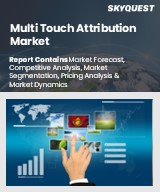
세계의 멀티 터치 어트리뷰션 시장 규모는 2023년에 38억 달러로 평가되며, 예측 기간(2025-2032년)의 CAGR은 13.6%로 성장하며, 2024년 43억 2,000만 달러에서 2032년에는 119억 7,000만 달러로 성장할 전망입니다.
멀티터치 어트리뷰션(MTA) 시장은 인공지능, 머신러닝, 프라이버시 분석의 발전으로 소셜미디어, 이메일, IoT 기기 등 다양한 채널에 걸친 고객 여정 매핑을 강화하는 인공지능, 머신러닝, 프라이버시 분석의 발전으로 인해 크게 성장하고 있습니다. 어도비 익스피리언스 클라우드와 같은 클라우드 기반 솔루션은 실시간 캠페인 최적화를 촉진하고 소매, 금융, 의료 등의 분야에서 큰 ROI를 가져다줍니다. 광고가 지원하는 IoT와 옴니채널 마케팅에 대한 의존도가 높아지면서 이러한 수요를 더욱 부추기고 있습니다. 그러나 소비자 데이터를 위험에 빠뜨리는 침해로 대표되는 사이버 보안 위협 증가는 개인정보를 보호하고 소비자의 신뢰를 강화하기 위해 안전한 서버 측 암호화 추적과 GDPR(EU 개인정보보호규정) 및 CCPA 동의 모델을 준수해야 할 필요성을 강조하고 있습니다.
Global Multi Touch Attribution Market size was valued at USD 3.8 billion in 2023 and is poised to grow from USD 4.32 billion in 2024 to USD 11.97 billion by 2032, growing at a CAGR of 13.6% during the forecast period (2025-2032).
The Multi-Touch Attribution (MTA) market is witnessing significant growth driven by advancements in artificial intelligence, machine learning, and privacy analytics that enhance the mapping of customer journeys across various channels, including social media, email, and IoT devices. Cloud-based solutions like Adobe Experience Cloud facilitate real-time campaign optimization, delivering substantial ROI for sectors such as retail, finance, and healthcare. The increasing reliance on ad-supported IoT and omnichannel marketing further fuels this demand. However, the rise in cybersecurity threats, exemplified by breaches compromising consumer data, underscores the necessity for secure, server-side encrypted tracking and compliance with GDPR and CCPA consent models to protect personal information and fortify consumer trust.
Top-down and bottom-up approaches were used to estimate and validate the size of the Global Multi Touch Attribution market and to estimate the size of various other dependent submarkets. The research methodology used to estimate the market size includes the following details: The key players in the market were identified through secondary research, and their market shares in the respective regions were determined through primary and secondary research. This entire procedure includes the study of the annual and financial reports of the top market players and extensive interviews for key insights from industry leaders such as CEOs, VPs, directors, and marketing executives. All percentage shares split, and breakdowns were determined using secondary sources and verified through Primary sources. All possible parameters that affect the markets covered in this research study have been accounted for, viewed in extensive detail, verified through primary research, and analyzed to get the final quantitative and qualitative data.
Global Multi Touch Attribution Market Segments Analysis
Global Multi Touch Attribution Market is segmented by Model Type, Component, Deployment Mode, Organization Size, End-User Industry and region. Based on Model Type, the market is segmented into Linear Attribution, Time-Decay Attribution, U-Shaped Attribution, W-Shaped Attribution and Algorithmic/Data-Driven Attribution. Based on Component, the market is segmented into Solutions and Services. Based on Deployment Mode, the market is segmented into Cloud, On-Premise. Based on Organization Size, the market is segmented into Small and Medium Enterprises (SMEs) and Large Enterprises. Based on End-User Industry, the market is segmented into Retail and e-commerce, BFSI, IT and Telecom, Consumer Electronics, Travel and Tourism and Others. Based on region, the market is segmented into North America, Europe, Asia Pacific, Latin America and Middle East & Africa.
Driver of the Global Multi Touch Attribution Market
One of the key market drivers for the Global Multi-Touch Attribution Market is the increasing demand for data-driven marketing strategies among businesses. As companies strive to enhance their return on investment (ROI) from marketing efforts, the need for accurate measurement of customer journeys across multiple channels has become essential. Multi-touch attribution provides insights that enable marketers to understand which touchpoints are most influential in driving conversions, thus allowing for optimized budget allocation and more effective campaign strategies. This heightened focus on analytics and performance measurement is propelling the adoption of multi-touch attribution solutions across various industries.
Restraints in the Global Multi Touch Attribution Market
One significant market restraint faced by the global multi-touch attribution market is the complexity of data integration and analysis. As marketing channels multiply and become more fragmented, businesses struggle to consolidate and accurately analyze data from various sources. This fragmentation can lead to inconsistencies in attribution models and hinder precise measurement of campaign performance. Additionally, a lack of standardization in data collection methods and varying privacy regulations further complicate the ability to fully leverage multi-touch attribution. Consequently, organizations may be hesitant to invest in such systems, fearing inadequate returns due to the intricacies involved in properly implementing and interpreting these models.
Market Trends of the Global Multi Touch Attribution Market
The Global Multi Touch Attribution (MTA) market is experiencing a significant trend driven by the convergence of predictive analytics and artificial intelligence. Businesses are increasingly adopting AI-powered algorithmic MTA models, which enhance the ability to deliver personalized experiences and dynamic attribution insights. These advanced models leverage vast amounts of data to identify high-impact touchpoints within customer journeys, ensuring that marketing campaigns are executed with remarkable precision. This growing sophistication in MTA not only optimizes campaign effectiveness but also fosters substantial sales growth across various sectors, as companies realize the strategic advantages of data-driven decision-making in complex marketing landscapes.